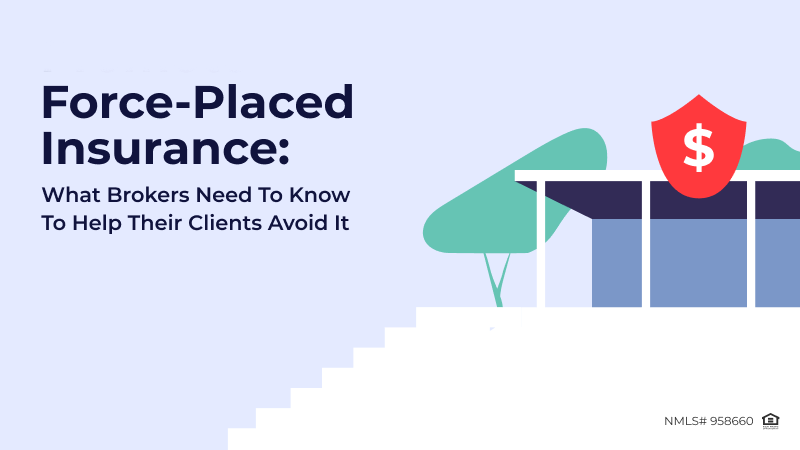
You successfully closed a loan, and your client happily settled into their new home and started to make their monthly payments, but suddenly the amount of those payments inexplicably increased. A frantic phone call reveals the culprit: a force-placed insurance (FPI) policy. Your client had unknowingly allowed their homeowner’s insurance to lapse. The lender stepped in with force-placed mortgage insurance, leaving your client frustrated with the inflated costs. This scenario, while avoidable, highlights a critical task for mortgage brokers: understanding the nature of force-placed insurance and helping clients steer clear of its financial pitfalls.
While FPI protects the lender’s investment, it comes with a hefty price tag for your clients. These policies are often significantly more expensive than standard homeowner’s insurance, and they typically offer less coverage. This double whammy can strain your clients’ budgets and leave their homes inadequately protected. Moreover, such a situation can damage your reputation. Your client may feel that you didn’t provide them with the proper guidance, leading to negative word-of-mouth and potentially impacting future referrals. Additionally, dealing with clients involved in FPI issues wastes valuable time that could be spent on new loan applications.
So, by educating your clients on FPI, you create a win-win situation. While they avoid falling into this costly trap, you maintain a strong, positive relationship built on trust and expertise. This article will help you get a handle on what force-placed insurance is, its implications, and strategies for assisting clients in avoiding it.
What is Force-Placed Insurance?
Force-placed insurance is coverage arranged by a mortgage lender when a homeowner fails to maintain the required property insurance, ensuring the lender’s interests are protected. Property insurance is essential for safeguarding a homeowner’s investment and financial security against unforeseen damages from fire, storms, floods, or other disasters. Often a requirement, this insurance must be maintained to avoid leaving the collateral uninsured. If the homeowner lapses in maintaining this coverage, the lender steps in with force-placed insurance.
Looking for a suitable loan program?
Choose among 20+ programs and get
a detailed loan calculation
While FPI ensures that the property remains insured and may seem like a safety net, it comes with a nasty surprise: a significantly higher price. But how does your client fall into this financial trap? The most common scenario is when a homeowner’s insurance policy lapses. Life gets busy, and sometimes a crucial renewal notice gets overlooked. If your client forgets to pay their regular homeowner’s insurance premium, the policy could lapse, triggering the lender to secure FPI.
When it comes to FPI, you may also come across terms such as lender-placed insurance, creditor-placed insurance, or even collateral protection insurance. They are often used interchangeably, and they are usually all about the same thing.
Lender-placed and creditor-placed refer to similar scenarios as FPI, where the lender or creditor obtains an insurance policy on the property to protect their financial interest when the homeowner’s insurance is not in effect.
Collateral protection insurance is considered a broader term that can apply to insurance placed on any collateral securing a loan, not just real estate. This could include vehicles or other assets used to secure a loan.
Implications of Force-Placed Insurance
As we’ve mentioned before, force-placed insurance often leads to significantly higher costs compared to traditional homeowner’s insurance. There are no phony exaggerations here, just simple arithmetic! According to NAR, “The average insurance rate is $2,377 annually.” Forbes points out, “It [force-placed insurance] can cost four to 10 times more than a typical homeowners insurance policy.”
But where does this cost difference come from? There are some factors that drive it. Firstly, this kind of insurance covers houses that might be riskier, like ones that didn’t have insurance before. Insurance companies charge more to cover riskier things. Secondly, the lender has to find an insurance company willing to cover the house and do extra paperwork. These extra costs get added to your client’s bill. Thirdly, when your clients shop for homeowner’s insurance, they compare rates from different providers, driving competition and potentially securing a lower price. With force-placed insurance, they can’t shop around for a better deal. The lender picks the company, and they might charge more because there’s no competition. And lastly, the insurance company that provides force-placed insurance might not offer the same discounts that a homeowner could get by shopping around.
All of this adds up to a much higher price for force-placed insurance. The high cost of force-placed insurance can put a strain on your client’s budget. This unexpected expense can make it difficult to manage other financial obligations and potentially lead to late mortgage payments. Late mortgage payments, in their turn, can even trigger foreclosure proceedings.
In addition to the financial burden and risks associated with higher costs, FPI carries another hidden drawback – limited coverage. For instance, furniture, appliances, and valuables might not be covered in case of a disaster. Liability protection or specific perils like floods or earthquakes might be also missing, exposing your client to additional financial risks.
Common Reasons for Force-Placed Insurance
The most common reason for FPI is the one we’ve already touched on – the policy lapses or gets canceled due to non-payment. Although the regulations require that a borrower be notified “at least 45 days before” the lender purchases the policy themselves, sometimes important paperwork slips through the cracks, and a borrower misses this renewal. This triggers a clause in the mortgage agreement, allowing the lender to secure force-placed insurance on their behalf.
Another common reason is coverage shortfall. The lender might have specific requirements for the type and amount of coverage your client’s insurance provides. If their existing policy doesn’t meet these requirements – for example, insufficient dwelling coverage or missing liability protection – the lender might turn to force-placed insurance to fill the gap.
Even if your client realizes their policy is lapsed or insufficient, there’s a potential catch. Securing a new homeowner’s insurance policy can take time. During this gap, the lender might activate force-placed insurance to ensure the property remains covered, even if it’s a temporary solution.
How Brokers Can Help Clients Avoid Force-Placed Insurance
Keeping Homeowner’s Insurance Uninterrupted
To prevent lapses, it’s important that your clients keep their homeowner’s insurance uninterrupted. It’s a crucial pillar of responsible homeownership, just like paying the mortgage on time. So, encourage your clients to set up automatic renewals or calendar reminders to prevent situations that trigger force-placed insurance. Federal regulations (CFR § 1024.37) require lenders to have a “reasonable basis” when assessing a borrower’s insurance coverage. This means they can’t impose force-placed insurance unless they have a reasonable belief that the borrower lacks adequate coverage. By demonstrating continuous coverage, your clients will avoid situations where the lender feels justified in resorting to force-placed insurance based on concerns about gaps in coverage.
Educating Clients about the Risks and Costs
Another way to sidestep FPI is by educating clients about the risks and costs force-placed insurance entails. Knowledge is power. Many don’t even realize that it can be much more expensive and provide less coverage compared to regular insurance. Explain how it can significantly inflate their monthly payments, provide real data, and show stats on the actual costs and coverage.
Reviewing Insurance Policies Regularly
Regularly reviewing insurance policies is another preventative measure. Don’t wait until your client comes to you with a renewal notice. Schedule regular check-ins to review their homeowner’s insurance details and ensure the coverage remains adequate. Has the value of their home increased? Do they need additional protection against specific risks? This proactive approach will prevent gaps in coverage.
Checking Competitive Homeowner’s Insurance Rates
Encourage your clients to shop around for competitive homeowner’s insurance rates well before their policy comes up for renewal. The more quotes they gather, the higher the chance of securing a good deal. This not only saves them money but also reduces the risk of the lender deeming their existing policy insufficient
Even if force-placed insurance becomes a reality, there’s still a way out. Encourage your client to obtain a new, compliant homeowner’s insurance policy as soon as possible. Once they have proof of this new policy, they can provide it to the lender to remove the force-placed insurance and its associated high costs. Regulations often allow a short window for clients to rectify coverage issues before force-placed insurance becomes permanent.
AD Mortgage’s Role in Supporting Brokers

Struggling with
a loan scenario?
Get a solution in 30 minutes! Fill out
the short form and get your personal offer
At AD Mortgage, we understand the importance of protecting your clients’ best interests. We offer a wealth of resources to help you educate your clients on key mortgage issues, as well as homeowner’s insurance and avoiding FPI. These include the AD Learning Center with educational modules and video tutorials on various loan scenarios and processes, the AD Studio with marketing materials, informative webinars with the ability to view past sessions as recordings, a blog with expert perspectives, industry updates, and practical tips. We also offer free online tools to streamline your workflow and make processes smoother. These include our mortgage calculator Quick Pricer, Scenario Request service, Concierge Service, and our new enhanced Broker Portal.
By leveraging AD Mortgage’s resources and expertise, you can confidently guide your clients through the mortgage process, minimize risks, and ensure they have the support they need.
Conclusion
Force-placed insurance can become a significant financial burden for your clients. But if you are well aware of its implications, the triggers that activate it, and the proactive steps to take when it is placed, you can protect your clients’ financial well-being. By encouraging continuous coverage, educating your clients about the risks, and checking in with them regularly, you can help them avoid the pitfalls of force-placed insurance and ensure they have the peace of mind that comes with proper homeowner’s insurance protection.
Contact AD Mortgage to explore how our expertise and resources can help you ensure your clients’ financial security.


